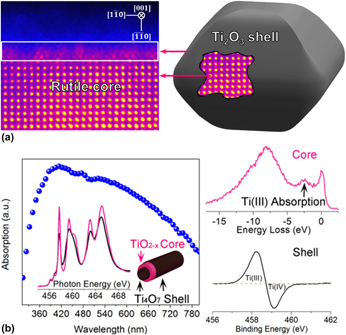Crossref Citations
This article has been cited by the following publications. This list is generated based on data provided by
Crossref.
Lin, Lina
Ma, Yanling
Wu, Jianbo
Pang, Fei
Ge, Jianping
Sui, Song
Yao, Yefeng
Qi, Ruijuan
Cheng, Yan
Duan, Chun-gang
Chu, Junhao
and
Huang, Rong
2019.
Origin of Photocatalytic Activity in Ti4+/Ti3+ Core–Shell Titanium Oxide Nanocrystals.
The Journal of Physical Chemistry C,
Vol. 123,
Issue. 34,
p.
20949.
Khan, Sovann
Je, Minyeong
Kim, Donghun
Lee, Seungwoo
Cho, So-Hye
Song, Taeseup
and
Choi, Heechae
2020.
Mapping Point Defects of Brookite TiO2 for Photocatalytic Activity Beyond Anatase and P25.
The Journal of Physical Chemistry C,
Vol. 124,
Issue. 19,
p.
10376.
Boboriko, Natalia E.
and
Sviridov, Dmitry V.
2020.
Synthesis, structural features and gas-sensing properties of highly defective titanium dioxide.
Journal of the Belarusian State University. Chemistry,
p.
89.
Rajaraman, T.S.
Parikh, Sachin P.
and
Gandhi, Vimal G.
2020.
Black TiO2: A review of its properties and conflicting trends.
Chemical Engineering Journal,
Vol. 389,
Issue. ,
p.
123918.
Abdelmaksoud, M. K.
Sayed, Abderrahman
Sayed, Sarah
and
Abbas, M.
2021.
A novel solar radiation absorption enhancement of TiO2 nanomaterial by a simple hydrogenation method.
Journal of Materials Research,
Vol. 36,
Issue. 10,
p.
2118.
Ahmad, Waleed
Park, Eunseuk
Lee, Heehyeon
Kim, Jin Young
Kim, Byoung Chan
Jurng, Jongsoo
and
Oh, Youngtak
2021.
Defective domain control of TiO2 support in Pt/TiO2 for room temperature formaldehyde (HCHO) remediation.
Applied Surface Science,
Vol. 538,
Issue. ,
p.
147504.
Nanda Gopala Krishna, D.
George, R.P.
and
Philip, John
2021.
Role of Oxygen Vacancy Formation Energy and Insulating Behavior in Darkening of White Amorphous TiO2.
The Journal of Physical Chemistry C,
Vol. 125,
Issue. 29,
p.
16136.
Mousavi, Mitra
Soleimani, Meisam
Hamzehloo, Majid
Badiei, Alireza
and
Ghasemi, Jahan B.
2021.
Photocatalytic degradation of different pollutants by the novel gCN-NS/Black-TiO2 heterojunction photocatalyst under visible light: Introducing a photodegradation model and optimization by response surface methodology (RSM).
Materials Chemistry and Physics,
Vol. 258,
Issue. ,
p.
123912.
Escaliante, Lucas Caniati
Pereira, Andre Luis de Jesus
Affonço, Lucas Jorge
and
da Silva, Jose Humberto Dias
2021.
Multilayered TiO2/TiO2−x/TiO2 films deposited by reactive sputtering for photocatalytic applications.
Journal of Materials Research,
Vol. 36,
Issue. 15,
p.
3096.
Liang, Ying
Huang, Guohe
Xin, Xiaying
Yao, Yao
Li, Yongping
Yin, Jianan
Li, Xiang
Wu, Yuwei
and
Gao, Sichen
2022.
Black titanium dioxide nanomaterials for photocatalytic removal of pollutants: A review.
Journal of Materials Science & Technology,
Vol. 112,
Issue. ,
p.
239.
Gordeeva, Alisa
Thersleff, Thomas
Hsu, Ying-Jui
Liebske, Christian
Ulmer, Peter
Andersson, Ove
and
Häussermann, Ulrich
2023.
Electronic structure characterization of TiO2-II with the α-PbO2 structure by electron-energy-loss-spectroscopy and comparison with anatase, brookite, and rutile.
Journal of Solid State Chemistry,
Vol. 322,
Issue. ,
p.
123952.
Amiri, Mehran
Lulich, Alice
Chiu, Nan-Chieh
Wolff, Samuel
Fast, Dylan B.
Stickle, William F.
Stylianou, Kyriakos C.
and
Nyman, May
2023.
Bismuth-Polyoxocation Coordination Networks: Controlling Nuclearity and Dimension-Dependent Photocatalysis.
ACS Applied Materials & Interfaces,
Vol. 15,
Issue. 14,
p.
18087.
Campbell, Lachlan
Nguyen, Song Ha
Webb, Hayden K.
and
Eldridge, Daniel S.
2023.
Photocatalytic disinfection of S. aureus using black TiO2−x under visible light.
Catalysis Science & Technology,
Vol. 13,
Issue. 1,
p.
62.
Berends, Dennis
Schwager, Patrick
Gehrke, Kai
Vehse, Martin
and
Agert, Carsten
2024.
Analysis of the Inhomogeneous Growth of Sputtered Black TiO2 Thin Films.
ACS Omega,
Vol. 9,
Issue. 13,
p.
15251.





